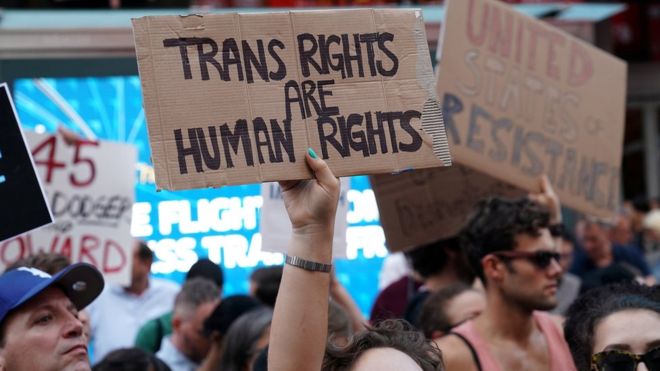
Kathmandu (Pahichan) January 23 – The United States Supreme Court on Tuesday (Wednesday NZT) allowed President Donald Trump’s broad restrictions on transgender people serving in the military to go into effect while the legal battle continues in lower courts.
The justices lifted nationwide injunctions that had kept the administration’s policy from being implemented.
It reversed an Obama-administration rule that would have opened the military to transgender men and women, and instead barred those who identify with a gender different from the one assigned at birth and who are seeking to transition.
The court’s five conservatives – Chief Justice John Roberts Jr and Justices Clarence Thomas, Samuel Alito Jr, Neil Gorsuch and Brett Kavanaugh – allowed the restrictions to go into effect while the court decides to whether to consider the merits of the case.
The liberal justices – Ruth Bader Ginsburg, Stephen Breyer, Sonia Sotomayor and Elena Kagan – would have kept the injunctions in place.
Trump surprised even his own military advisers in July 2017 when he announced a sweeping ban on transgender people’s military service via Twitter.
He cited what he viewed as the “tremendous medical costs and disruption”. The administration’s order reversed President Barack Obama’s policy of allowing transgender men and women to serve openly and receive funding for sex-reassignment surgery.

Attorneys for active-duty service members went to court to block the policy shift, which could subject current transgender service members to discharge and deny them certain medical care.
The court rulings were met with another policy revision from then-Secretary of Defence Jim Mattis, who issued a plan to bar those from the military who identify with a gender different from their birth gender and who are seeking to transition.
Mattis’s plan makes exceptions, for instance, for about 900 transgender individuals who are already serving openly and for others who would serve in accordance with their birth gender.
While several lower courts have blocked the policy, the changes were persuasive to a panel of the US Court of Appeals for the DC Circuit, which became the first appeals court to review the policy.
“The government took substantial steps to cure the procedural deficiencies” previously identified by a lower court, the panel said in a short order.
“Although the Mattis Plan continues to bar many transgender persons from joining or serving in the military, the record indicates that the plan allows some transgender persons” previously barred to join and serve.
The policy is not a “blanket ban”, the court concluded, because “not all transgender persons seek to transition to their preferred gender or have gender dysphoria”.

The controversy over allowing transgender service members to serve openly has a long past.
The Obama administration opened the military to transgender service members in June 2016, focusing first on allowing those already in the service to remain in legally and then with providing them medical care.
In announcing the policy change, then-defence secretary Ashton B Carter said that the administration did not want “barriers unrelated to a person’s qualification to serve” preventing the military from recruiting or retaining the best people available for the job.
The policy approved said that “not later than July 1, 2017”, the Pentagon would update its medical standards to include people who have a history of gender dysphoria, the medical term for wanting to transition gender. It added that the Pentagon would begin taking transgender recruits in July 2017 for the first time as long as a doctor certified that they were mentally and emotionally stable over the previous 18 months.
Mattis, Trump’s first defence secretary, delayed opening the military to transgender recruits on the eve of that deadline by another six months, citing a request from the Joint Chiefs of Staff for further study.
In the meantime, the Pentagon would continue to treat transgender troops with dignity and respect, Mattis said in a memo. Advocates for transgender people decried the move, saying it already had been studied ad nauseam.
Trump issued a presidential memorandum the following month that accused the Obama administration of allowing transgender military service without identifying a “sufficient basis” that doing so would not “hinder military effectiveness and lethality, disrupt unit cohesion, or tax military resources”.
He directed Mattis to have the Pentagon adopted a new ban similar to the military’s former policy by March 23, 2018.
With legal battles still underway, Mattis wrote in a memo to the president that he was in favour of letting most transgender troops already in the military stay, so long as they have not undergone gender reassignment surgery and are able to deploy across the world.
Service members who had been diagnosed with gender dysphoria since the Obama administration ended the ban in 2016 should be allowed to continue serving, Mattis added, effectively advocating the grandfathering of anyone affected by Trump’s ban.
But Mattis’s view on bringing in additional transgender people as recruits was more closely aligned with the president’s.
“By its very nature, military service requires sacrifice,” Mattis said in the memo.
“The men and women who serve voluntarily accept limitations on their personal liberties – freedom of speech, political activity, freedom of movement – in order to provide the military lethality and readiness necessary to ensure American citizens enjoy their personal freedoms to the fullest extent.”
Federal judges required the military to begin allowing transgender recruits beginning in January 2018, and the Pentagon has not stood in the way of those rulings. Instead, it provided policy guidance to recruiters to explain how to enlist transgender men and women, and said those guidelines “shall remain in effect until expressly revoked”.
The Washington Post
Copyright © All right reserved to pahichan.com Site By: Sobij.